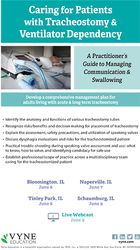

Develop a comprehensive management plan for adults living with acute & long–term tracheostomy
As medical technology and intervention evolves, more patients are faced with temporary and long–term tracheostomy/ventilation as a part of their recovery. The very presence of a tracheostomy tube may elicit visceral reaction to secretion management and dehumanize the patient who is unable to exercise their decision making capacity, orally communicate their needs, and interact socially with staff or family. Practitioners in acute hospitals, transitional rehabilitation units, skilled long–term settings, and homecare arenas are challenged to not only understand the basic functionality of a tracheostomy tube, but complete daily cares, assist their patients with swallowing and oral communication, and even train non-medical care providers. Management of the tracheostomized patient is often assumed to be complex. This misconception may become a barrier for placement in an environment most conducive to overall rehabilitation; to foster social closeness with staff, friends and family; and ultimately result in prolonging the weaning process.
This course will outline and compare the basic components of a tracheostomy tube, decision making surrounding the most appropriate type of tube to use for various populations, and the risks/benefits of placement. Through review of daily cares, the assessment and placement of a speaking valve, and dysphagia characteristics for this population, course participants will build the skills and confidence necessary to develop a comprehensive management plan. Attendees of this seminar will leave with a solid foundation of general knowledge, critical thinking algorithms, and an understanding of the roles and responsibilities of their specialty when faced with tracheostomized patients.
is an approved provider #50-466 with the Florida Department of Health Board of Occupational Therapy Practice. This course is approved for 6 contact hour(s) for Occupational Therapist and Occupational Therapy Assistants.
This educational offering qualifies for 6 continuing education hour(s) as required by many national, state and local licensing boards and professional organizations. Save your course outline and certificate of completion, and contact your own board or organization for specific filing requirements.
This educational offering qualifies for 6 continuing education hour(s) as required by many national, state and local licensing boards and professional organizations. Save your course outline and certificate of completion, and contact your own board or organization for specific filing requirements.
| File type | File name | Number of pages | |
|---|---|---|---|
| Course Manual_Caring For Patients with Tracheostomy (8.58 MB) | Available after Purchase |
JEROME QUELLIER, MS, CCC-SLP, is a licensed Speech-Language Pathologist with over 20 years of acute care experience whose clinical subspecialties include swallowing, traumatic brain injury, stroke rehabilitation, oral-pharyngeal cancer rehabilitation, and assisting patients in palliative decision making for the dysphasic patient. He is currently a Clinical Specialist at a Level 1 trauma hospital in Saint Paul, Minnesota, treating neurologically impaired adults and geriatrics and managing Tracheoesophageal Prosthesis (TEP) care. Additionally, he treats head and neck cancer patients in conjunction with the Department of Radiation Oncology, amd trains hospital-based rehab staff, nurses, and internal medicine residents on the management of this unique population.
Mr. Quellier has been a faculty member at the University of Minnesota-Duluth and adjunct faculty at the University of Wisconsin, teaching graduate coursework on tracheostomy and head and neck cancer. He also possesses extensive experience in quality and process improvement for rehabilitation services. Mr. Quellier received his bachelor’s and master’s degrees from the University of Wisconsin-Eau Claire. During his professional tenure, he has been a direct care provider in hospitals, skilled nursing facilities and homecare settings, and has acted as the shared services coordinator between various community hospitals.
Disclosure:
ANATOMY AND PHYSIOLOGY OF TRACHEOSTOMY
CLINICAL FEATURES OF A TRACHEOSTOMY TUBE INTUBATION AND TRACHEOSTOMY - BENEFITS AND RISKS
SIZING TRACHEOSTOMY TUBES
MANUFACTURERS OF TRACHEOSTOMY TUBES
SPECIAL CONSIDERATIONS OF MANAGING A TRACHEOSTOMY TUBE
SPEAKING VALVES
FENESTRATED TRACHEOSTOMY TUBES
DYSPHAGIA AND THE TRACHEOTOMIZED PATIENT
MULTIDISCIPLINARY CARE OF A PATIENT WITH TRACHEOSTOMY
| 5 |
|
| 4 |
|
| 3 |
|
| 2 |
|
| 1 |
|
Satisfaction Guarantee
Your satisfaction is our goal and our guarantee. Concerns should be addressed to: PO Box 1000, Eau Claire, WI 54702-1000 or call 1-800-844-8260.
ADA Needs
We would be happy to accommodate your ADA needs; please call our Customer Service Department for more information at 1-800-844-8260.
Please wait ...